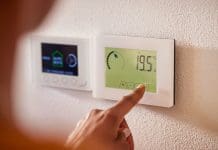Richard Tibenham of Greenlite Building Physics makes the case for higher fuel prices in an age of climate emergency
2019 was quite the year for raising the agenda of climate change. The UK saw records broken within the same year for both summer and wintertime temperatures. Globally, wildfires on an unprecedented level ravaged Australia and arctic sea ice fell to alarmingly low levels as temperatures continue to rise. Domestically, the politics surrounding the issue gained further momentum, yet the outcome of December’s general election confirmed that it was Brexit which trumped the majority of voters’ concerns.
So where does this leave us? The UK has set in law a target to bring UK greenhouse gas emissions to net-zero by 2050. The key questions remain, however, how are we going to get there, and more importantly, who’s going to pay for it? To date, despite the hype of calling ‘climate emergencies’ at national and local government levels, the actual response from policymakers to address the transition has been more ‘casual’ than ‘emergency’.
Construction in the firing line
The construction industry routinely finds itself in the firing line regarding environmental performance standards, with critics arguing that it should be doing more to address the issue. Understandably, the key performance indicator for most property developers is financial profit, and so it is of little surprise that various factions within the construction industry have lobbied government heavily over the years to relax energy efficiency performance requirements. Higher performance standards imply higher build costs, and if customers are unprepared to absorb these higher costs, this erodes profit margins.
And so here lies the problem. Buildings are long term pieces of infrastructure. What we build today will still be with us by 2050. Indeed, the majority of buildings standing today will still be with us by 2050. Short of nuclear fusion, no single technology offers an obvious ‘supply-side fix’, and this suggests that almost all buildings will need to be modified to some extent to operate in a zero-carbon manner.
From this perspective, the case to build to zero-carbon standards today makes total sense, given the substantially higher costs of building to lesser standards initially, then refurbishing these properties at a later date. However, this is of zero concern if the objective of the exercise is to maximise short-term profits and shareholder dividends. Likewise, the typical consumer isn’t thinking 30yrs down the line and instead, they principally base their decision making on the needs of the here and now. This, I believe, must change if we are to deliver a zero-carbon economy.
Energy efficiency has value
Energy efficiency must be perceived as having value if it is to become an attractive proposition to buyers and sellers alike. The construction industry will respond to changes in demand from its customer base, but so long as customers favour other attributes over energy efficiency measures, developers will be reluctant to include them.
Take as an example the Passivhaus EnerPHit Plus refurbishment of two Victorian townhouses in Zetland Road, Manchester. The project incorporates very high energy efficiency standards, representative of the performance standards necessary to realistically achieve zero-carbon operation in the built environment. One would think it prudent to encourage such activities, thereby developing the knowledge and skills base necessary to deliver a zero-carbon future, yet the tax system and public policy encourage the direct opposite.
The cost to buy and refurbish both townhouses to the Passivhaus EnerPHit Plus standard was £1.75mil, yet each property is on the market at just £925,000 – offering a profit margin of just 5%. Compare this to the profit margins on a typical Persimmon home, of around 28%, and it becomes quite evident why the construction industry isn’t building to zero-carbon standards en masse. There’s no money in energy efficiency.
Furthermore, the developer of the Zetland Road project claims that that energy costs to run each home will be reduced from £650 to £300 a year. By comparison to mortgage costs, such negligible financial savings offer little attraction on financial grounds. If you can afford the £925,000 price tag, then chances are that an extra £350 on your energy bill each year will be of little concern. And so, inevitably, this project and others like them serve only a niche corner of the market, catering to those customers who can afford to ‘do the right thing’.
Cheap fuel is the enemy of efficiency
So, what about the rest of the market? What if you can’t afford to do the right thing? Why is it that the market doesn’t value energy efficiency at a time of ‘climate crisis’? Why is it that the market offers such a limited range of performance standards? The answer is quite simple. By comparison to property purchase costs, energy is too cheap. Cheap fuel is the enemy of efficiency.
Cheap fuel increases ROI periods on energy efficiency improvements. Based on the current balance between property prices and energy costs, only the shortest ROI periods are attractive to the mass market. For the retrofit market, this principally means solar PV and LED lighting, which are both positive steps, but far from sufficient to deliver zero-carbon operation. For more costly and disruptive measures, including heat pumps, EWI all the way up to deep refurbishment projects such as the Zetland Road project, ROIs of increasingly unattractive periods are incurred.
Shift in policy needed to encourage uptake of energy efficiency measures
Conversely, the wastage of fuel is actively encouraged via the reduced 5% VAT rate on domestic fuel. This compares to fuel duty on petrol of approximately 47% based on today’s prices. Whilst this has pandered to the desires of the electorate, it has also legitimised a state of apathy surrounding the topic of fuel efficiency in the built environment.
Whilst installed insulation materials benefit from a reduced 5% VAT rate, other materials necessary for low-energy refurbishment work all attract VAT at the standard 20% rate. This includes mechanical ventilation systems, airtightness products, triple glazed windows and solar PV cells.
If low energy refurbishment works are to be incentivised, then there must be a shift in policy such that fuel costs are increased and capital costs for low-energy refurbishment works are decreased. At a minimum, the market requires a level playing field so far as fuel and fuel saving measures costs are concerned.
Whilst tax rises are never welcomed by the electorate, change will be necessary if a zero-carbon economy is to be realised. I would argue that if we want to achieve zero-carbon, we must start accounting for the real cost of fuel.
Richard Tibenham MCIBSE LCC LCEA
Director
Greenlite Building Physics
Tel: 01522 581234
LinkedIn: Richard Tibenham Greenlite EA
Please note: this is a commercial profile.





![[Video] Enhancing safety with fire doors: A case study of Marina Care Home](https://www.pbctoday.co.uk/news/wp-content/uploads/2025/06/maxresdefault-218x150.jpg)








